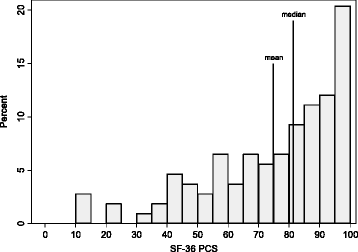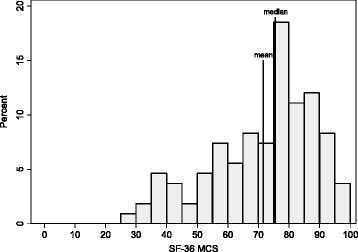Predictors of quality of life among adolescents and young adults with a bleeding disorder
- PMID: 28388906
- PMCID: PMC5383972
- DOI: 10.1186/s12955-017-0643-7
Predictors of quality of life among adolescents and young adults with a bleeding disorder
Abstract
Background: Health-related quality of life (HRQoL) in adolescents and young adults with bleeding disorders is under-researched. We aimed to describe factors related to HRQoL in adolescents and young adults with hemophilia A or B or von Willebrand disease.
Methods: A convenience sample of volunteers aged 13 to 25 years with hemophilia or von Willebrand disease completed a cross-sectional survey that assessed Physical (PCS) and Mental (MCS) Component Summary scores on the SF-36 questionnaire. Quantile regression models were used to assess factors associated with HRQoL.
Results: Of 108 respondents, 79, 7, and 14% had hemophilia A, hemophilia B, and von Willebrand disease, respectively. Most had severe disease (71%), had never developed an inhibitor (65%), and were treated prophylactically (68%). Half of patients were aged 13 to 17 years and most were white (80%) and non-Hispanic (89%). Chronic pain was reported as moderate to severe by 31% of respondents. Median PCS and MCS were 81.3 and 75.5, respectively. Quantile regression showed that the median PCS for women (61% with von Willebrand disease) was 13.1 (95% CI: 2.4, 23.8; p = 0.02) points lower than men. Ever developing an inhibitor (vs never) was associated with a 13.1-point (95% CI: 4.7, 21.5; p < 0.01) PCS reduction. MCS was 10.0 points (95% CI: 0.7, 19.3; p = 0.04) higher for prophylactic infusers versus those using on-demand treatment. Compared with patients with no to mild chronic pain, those with moderate to severe chronic pain had 25.5-point (95% CI: 17.2, 33.8; p < 0.001) and 10.0-point (95% CI: 0.8, 19.2; p = 0.03) reductions in median PCS and MCS, respectively.
Conclusions: Efforts should be made to prevent and manage chronic pain, which was strongly related to physical and mental HRQoL, in adolescents and young adults with hemophilia and von Willebrand disease. Previous research suggests that better clotting factor adherence may be associated with less chronic pain.
Keywords: Chronic pain; Hemophilia; Pain management; Patient adherence; Prophylaxis; von Willebrand disease.
Figures



Similar articles
-
Racial Differences in Chronic Pain and Quality of Life among Adolescents and Young Adults with Moderate or Severe Hemophilia.J Racial Ethn Health Disparities. 2016 Mar;3(1):11-20. doi: 10.1007/s40615-015-0107-x. Epub 2015 Apr 3. J Racial Ethn Health Disparities. 2016. PMID: 26896101 Free PMC article.
-
Predictors of non-adherence to prescribed prophylactic clotting-factor treatment regimens among adolescent and young adults with a bleeding disorder.Haemophilia. 2016 Jul;22(4):e245-50. doi: 10.1111/hae.12951. Epub 2016 May 24. Haemophilia. 2016. PMID: 27216992
-
Generic and disease-specific quality of life among youth and young men with Hemophilia in Canada.BMC Hematol. 2016 May 5;16:13. doi: 10.1186/s12878-016-0052-x. eCollection 2016. BMC Hematol. 2016. PMID: 27158500 Free PMC article.
-
Hemophilia And Von Willebrand Disease In Children: Emergency Department Evaluation And Management.Pediatr Emerg Med Pract. 2015 Sep;12(9):1-20; quiz 20-1. Pediatr Emerg Med Pract. 2015. PMID: 26284379 Review.
-
[Pain therapy for children and adolescents with hemophilia : Recommendations by an expert panel].Schmerz. 2018 Dec;32(6):404-418. doi: 10.1007/s00482-018-0321-7. Schmerz. 2018. PMID: 30191308 Review. German.
Cited by
-
Defining the Impact of Social Drivers on Health Outcomes for People with Inherited Bleeding Disorders.J Clin Med. 2022 Jul 30;11(15):4443. doi: 10.3390/jcm11154443. J Clin Med. 2022. PMID: 35956060 Free PMC article. Review.
-
Von Willebrand Disease Epidemiology, Burden of Illness and Management: A Systematic Review.J Blood Med. 2023 Mar 2;14:189-208. doi: 10.2147/JBM.S389241. eCollection 2023. J Blood Med. 2023. PMID: 36891166 Free PMC article. Review.
-
How I manage severe von Willebrand disease.Br J Haematol. 2019 Nov;187(4):418-430. doi: 10.1111/bjh.16186. Epub 2019 Sep 9. Br J Haematol. 2019. PMID: 31498884 Free PMC article. Review.
-
The lived experience of women with a bleeding disorder: A systematic review.Res Pract Thromb Haemost. 2022 Feb 3;6(1):e12652. doi: 10.1002/rth2.12652. eCollection 2022 Jan. Res Pract Thromb Haemost. 2022. PMID: 35141459 Free PMC article. Review.
-
Professional functioning of young adults with congenital coagulation disorders in the Netherlands.Haemophilia. 2019 May;25(3):e138-e145. doi: 10.1111/hae.13698. Epub 2019 Mar 12. Haemophilia. 2019. PMID: 30859671 Free PMC article.
References
-
- Lusher JM, Arkin S, Abildgaard CF, Schwartz RS. Recombinant factor VIII for the treatment of previously untreated patients with hemophilia a. Safety, efficacy, and development of inhibitors. Kogenate previously untreated patient study group. N Engl J Med. 1993;328(7):453–9. doi: 10.1056/NEJM199302183280701. - DOI - PubMed
-
- Franchini M, Mengoli C, Lippi G, Targher G, Montagnana M, Salvagno GL, et al. Immune tolerance with rituximab in congenital haemophilia with inhibitors: a systematic literature review based on individual patients’ analysis. Haemophilia. 2008;14(5):903–12. doi: 10.1111/j.1365-2516.2008.01839.x. - DOI - PubMed
MeSH terms
LinkOut - more resources
Full Text Sources
Other Literature Sources
Medical

